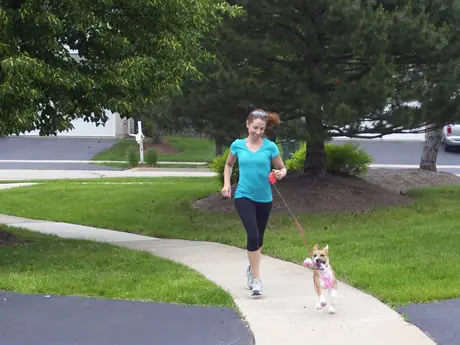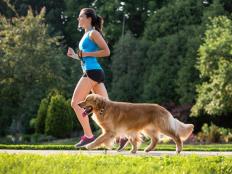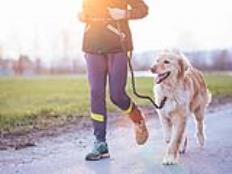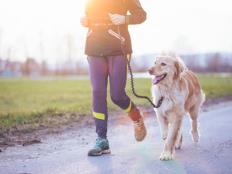5. Watch for cues.
Dogs are less complicated than humans. If they're tired, they flop on the ground. If they're thirsty, they drink. If they want to stop running, they will show cues. They may dawdle or just walk. Being receptive to their cues is crucial. Your dog knows what it needs.
My friend Cynthia recently started running with her dog. She knows when her dog Penny is ready for a rest when she stops often to pee:
More: Hit the Trails to Stay Injury Free
"For the past month, we have gone out about three to five times a week on this little 2K stroll and we do running pickups. Sometimes we do 2.5K depending on how she feels. If I see she is stopping often to do her business, I know it's not a good day so we take it easy."
6. Start with short, local loops.
I started Ginger with a single run around the block, letting her rest when she got tired. When she recovered, we'd go back out. As time passed, her distances got longer (more loops, less recovery).
When we got to the point where she could run steady for an hour or more without getting tired, we started taking her out to the trails.
7. Keep track.
As silly as it sounds, Ginger has a Dailymile account where I track her mileage. This helps tremendously as far as knowing what she's capable of and how far she's come. It helps me determine what types of distances and conditions she's ready for, and I note her mood and energy as well.
Every once in a while, tracking her progress also helps me call out and celebrate her milestones. We celebrated her highest elevation run. Her roughest terrain. We even note which wildlife she sees and how she responds.
I record Ginger's mileage in "Ginger-speak," typing about the run through her eyes. Here are some examples of her entries:
- "I SEEN THE DEER AND I HUNT HIM. IMA WOLF."
- "I RUNNED FAST AND THEN I STOP TO PEE."
- "I SEEN A CAT I TRY TO EAT IT."
- "TIME TO GET SERIOUS ABOUT MY TRAININ?.. SQUIRREL!!!!!!"
Ginger has had "Friends" add her and encourage her on her journey. I translate their messages by patting her head. You can add Ginger as a friend here.
All the benefits you get from tracking your own workouts apply to your dog as well. I strongly suggest keeping a log.
More: 3 Reasons Strength-Training Will Boost Your Running
8. Open a line of communication.
The dog-master relationship is precious and your dog will often be bonded to you more strongly than what you imagine. Communicate with them about running, and you'll be surprised at how much they actually understand and can share in your passion.
Tell your dog they're going for a run. They'll probably know exactly what you mean. This is my friend Cynthia's experience:
"I tell Penny the night before that we are going for a run in the morning and she knows what it means. Since (my husband) wakes up before me, she knows she still has some sleeping time until I wake up and we go.
When I get out of the bedroom, I ask her: 'Are you ready for your run?' and she gets so excited! Funny thing is she actually stretches before we leave. She does Downward Dog."
The book How to Talk to Your Animals describes how one dog owner started speaking English to his dog, and was shocked to find that his dog understood what he was saying.
"He speaks English!" he exclaimed to his wife. She looked at him in disgust, "Of course he speaks English! What's he going to speak, German?!"
The author goes on to describe how many words dogs have been known to retain, and tells stories of dogs in Mexico who understand Spanish. According to this book, it's easier for dogs to understand our language than for us to understand theirs.
Talk to your dog about running. This can keep you accountable as well. If you promised your dog a morning run the night before, you have to get up and do it.
- 2
- of
- 5
About the Author

Get ACTIVE on the Go


Couch to 5K®
The best way to get new runners off the couch and across the finish line of their first 5K.
Available for iOS | Android







Discuss This Article